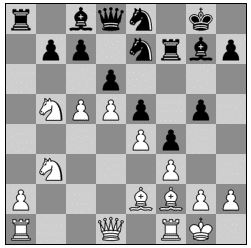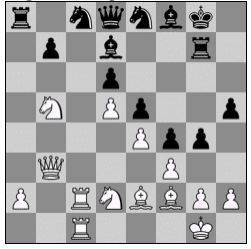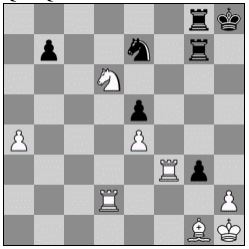Selected by judge FM David Griego as the most interesting game in the Mass Open’s top section, this King’s Indian frenzy is annotated by its survivor / winner, Boylston Chess Club president Andrew Hoy.
Andrew Hoy (2163)
Ian Lomeli (2028)
84th Massachusetts Open (4)
05.24.2015
King’s Indian (E97)
After a fairly lackluster start to the tournament, I was paired with Ian Lomeli. Ian and I have attended many of the same tournaments, but this was our first game. When I found out, to my horror, that this game won the "Most Interesting Game" prize, I was aghast that my blunders would be publicized for everyone to enjoy. Ian played a very thematic KID attack and I was saved only by a trick that he overlooked in my time pressure.
1. e4 g6 2. d4 Bg7 3. c4 d6 4. Nc3 Nf6 5. Be2 0-0 6. Nf3 e5 7. 0-0 Nc6 8. d5 Ne7 9. b4 a5
A sideline for Black, though not an uncommon one. I had seen a video by John Fedorowicz some years ago suggesting a quick capture on a5 followed by the repositioning of the f3 knight onto b3. Fedorowicz, who had been a big proponent of the KID, cited the bayonet attack as a reason for giving up the defence as Black.
10. bxa5 Rxa5 11. Nd2 Ne8 12. Nb3 Ra8 13. Be3
White tries to position the dark square bishop on the a7-g1 diagonal before it gets shut out by Black's advancing pawns. White can also advance the c pawn immediately, and after this game, there's a fair chance that I would proceed in that vein instead.
13... f5 14. f3 f4 15. Bf2 g5 16. c5 Rf7 17. Nb5

In the KID, Black throws everything at the white king. The c8 bishop is a crucial resource, often sacrificed on h3 or g2. While Black aims to checkmate White's king, White tries to checkmate the c7 square.
17... Bf8 18. cxd6 cxd6 19. Nd2 Bd7
The only good move to prevent Nc4!
20. Qb3 Nc8 21. Rfc1 h5 22. Rc2
Perhaps 22. Rc3 would be better, because on c2 the rook becomes a tactical target for Ba4 skewers. : 22. Rc3 Rg7 23. Rac1 g4 24. Nc7 Nxc7 25. Rxc7± and the rook on c7 basically shuts down Black's attack, e.g. 25... g3 26. hxg3 fxg3 27. Be3 Qh4 28. Nf1.
22... Rg7 23. Rac1 g4

To my horror, I realized now that my intended Nc7 was impossible because of Ba4, when Black's material advantage more than compensates for White's queenside pressure.
24. Kh1
Since the dark square bishop is about to run out of squares on the diagonal, the king must stalemate itself in the corner 24. Nc4 g3 25. hxg3 fxg3 26. Be3 Qh4-+; 24. Nc7 Ba4 25. Qb4 (25. Qxb7 Bxc2 26. Qxa8 Rxc7) 25... Nxc7
24... g3 25. Bg1 Qg5 26. Bf1 h4 27. Nc4
27. h3 Bxh3 28. Nc7 Nxc7 29. Rxc7 Bxg2+ 30. Bxg2 Ne7-+ 31. Nf1 h3 and the pressure is overwhelming, e. g. : 32. Bxh3 g2+ 33. Kh2 gxf1N+ 34. Rxf1 Qg3+ 35. Kh1 Qxh3+.
27... h3 28. a4
I was tempted by 28. gxh3 Qh5 29. a4 Bxh3 30. Bxh3 Qxh3 31. Rg2 Nf6 32. a5 Nh5 33. Qb4 gxh2 but there is no stopping ... Ng3.
28... Qh5 29. Rd2 Be7

30. Nxe5
The only practical solution to Black’s kingside assault.
30... hxg2+ 31. Rxg2
31. Bxg2 Qxe5 32. Bd4 Qh5-+
31... dxe5 32. d6+ Kh8 33. dxe7 Nxe7 34. Rd2 Nf6?
A misstep which let me back into the game. 34... Bh3 is the thematic next step in Black's winning attack.
35. Nd6 Rag8 36. Bg2 Ng4?
Again, 36... Bh3! is the proper continuation. But Black, after a lengthy think, goes for this fancy line, missing White's corresponding trick.
37. fxg4 Bxg4 38. Rf1 f3 39. Bxf3 Bxf3+ 40. Qxf3 Qxf3+ 41. Rxf3

After finally making time control, Black has to resign in the face of 41... g2+ 42. Rxg2 Rxg2 43. Rh3+!!, a miraculous saving throw.
1-0 |